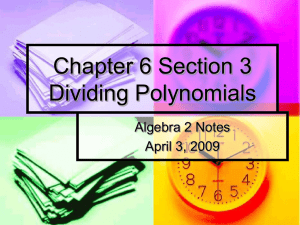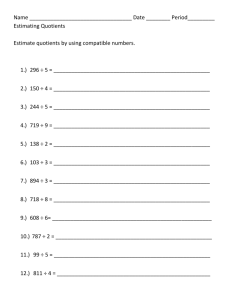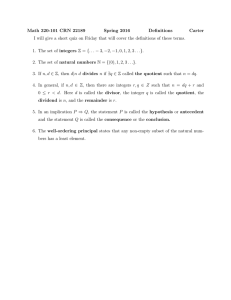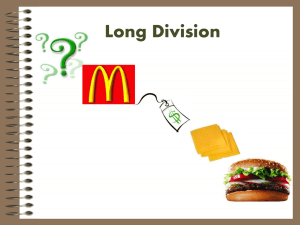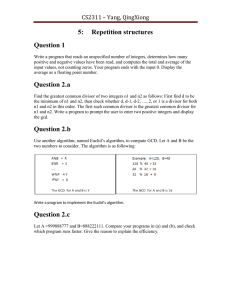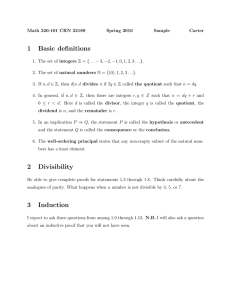MATH NEWS 6 Grade Math Grade 6, Module 2, Topic C
advertisement
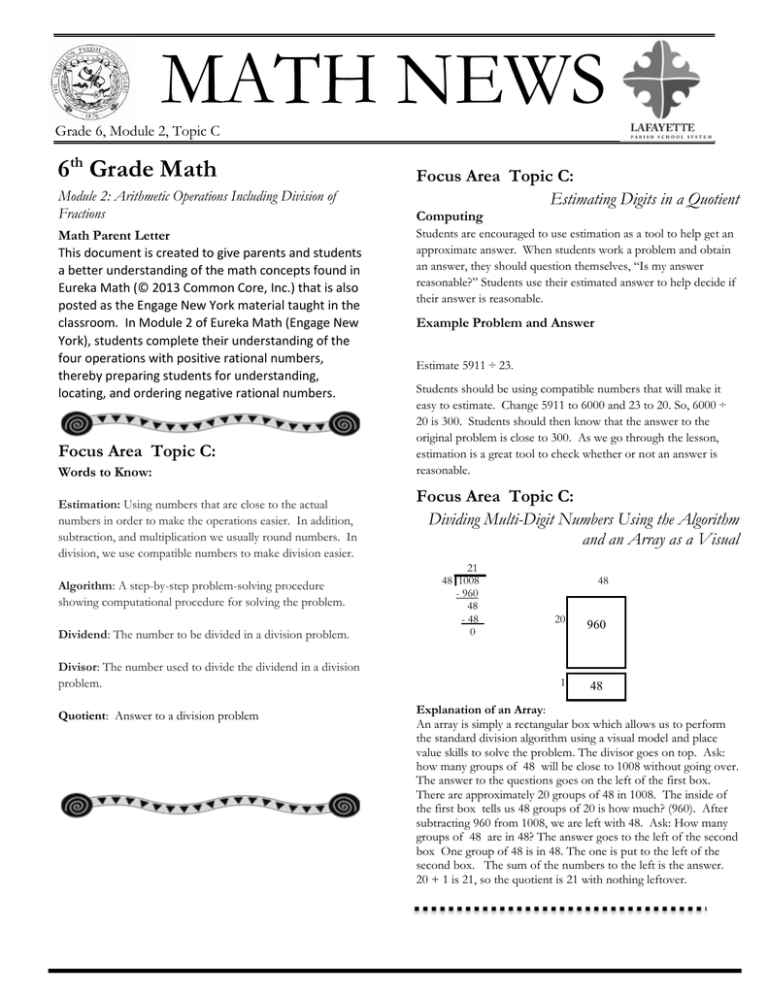
MATH NEWS Grade 6, Module 2, Topic C 6th Grade Math Module 2: Arithmetic Operations Including Division of Fractions Math Parent Letter This document is created to give parents and students a better understanding of the math concepts found in Eureka Math (© 2013 Common Core, Inc.) that is also posted as the Engage New York material taught in the classroom. In Module 2 of Eureka Math (Engage New York), students complete their understanding of the four operations with positive rational numbers, thereby preparing students for understanding, locating, and ordering negative rational numbers. Focus Area Topic C: Words to Know: Estimation: Using numbers that are close to the actual numbers in order to make the operations easier. In addition, subtraction, and multiplication we usually round numbers. In division, we use compatible numbers to make division easier. Algorithm: A step-by-step problem-solving procedure showing computational procedure for solving the problem. Dividend: The number to be divided in a division problem. Divisor: The number used to divide the dividend in a division problem. Quotient: Answer to a division problem Focus Area Topic C: Estimating Digits in a Quotient Computing Students are encouraged to use estimation as a tool to help get an approximate answer. When students work a problem and obtain an answer, they should question themselves, “Is my answer reasonable?” Students use their estimated answer to help decide if their answer is reasonable. Example Problem and Answer Estimate 5911 ÷ 23. Students should be using compatible numbers that will make it easy to estimate. Change 5911 to 6000 and 23 to 20. So, 6000 ÷ 20 is 300. Students should then know that the answer to the original problem is close to 300. As we go through the lesson, estimation is a great tool to check whether or not an answer is reasonable. Focus Area Topic C: Dividing Multi-Digit Numbers Using the Algorithm and an Array as a Visual 21 48 1008 - 960 48 - 48 0 48 20 1 960 48 Explanation of an Array: An array is simply a rectangular box which allows us to perform the standard division algorithm using a visual model and place value skills to solve the problem. The divisor goes on top. Ask: how many groups of 48 will be close to 1008 without going over. The answer to the questions goes on the left of the first box. There are approximately 20 groups of 48 in 1008. The inside of the first box tells us 48 groups of 20 is how much? (960). After subtracting 960 from 1008, we are left with 48. Ask: How many groups of 48 are in 48? The answer goes to the left of the second box One group of 48 is in 48. The one is put to the left of the second box. The sum of the numbers to the left is the answer. 20 + 1 is 21, so the quotient is 21 with nothing leftover. Focus Area Topic C: Expressing Remainders as a Decimal Example Problem and Answer: Students will extend their understanding of division by placing a decimal with zeros to express their answer in a more precise decimal form. State the power of 10 you would use to convert the given decimal division to whole number division. 38.9 ÷ 2.91= 13.36769759 Example Problem and Answer Divide 31,218 ÷ 132 As we divide, we can use our knowledge of place value to guide us. 236.5 132 31218.0 312 hundreds ÷ 132: 2 hundreds -264 481 481 tens ÷ 132: 3 tens -396 858 858 ones ÷ 132: 6 ones -792 660 660 tenths ÷ 132: 5 tenths - 660 0 Focus Area Topic C: Converting Decimal Division into Whole Number Division Students will multiply by powers of 10 if there is a decimal in the divisor. The purpose is to make the divisor a whole number. When students figure which power of 10 to use, they must also multiply the dividend by the same power of 10. Example Problem and Answer Divide 742.66 by 14.2 We can rewrite the division problem so that the divisor is a whole number and the quotient remains the same. This makes it easier to use the long division algorithm and yield the same answer. We can multiply both numbers by 10, so that the divisor will change from 14.2 to 142. Then we will have a whole number to divide by. We always multiply the dividend by the same power of 10. So the new problem will become 7,426.6 ÷ 142 52.3 142 7426.6 -710 326 -284 426 -426 0 We know to multiply the divisor by 10 because the original divisor is 14 and 2 tenths. If the number had been 14 and 25 hundredths (14.25) we would multiply the divisor by 100 to convert the divisor to the whole number 1425. Students would multiply the dividend and divisor by 100 or 102. The problem then becomes whole number division. If we multiply both the dividend and divisor by the same power of 10, the quotient will not change. 3890 ÷ 291 = 13.36769759 In the previous example, what would happen if we multiplied both the dividend and divisor by 1, 000, or 10,000 or 100,000? 38.9 x 1,000 = 38900 2.91 x 1,000 = 2910 38900 ÷ 2910 = 13.36769759 Through several examples such as this, students are convinced using this method does not change the answer; it only makes using the standard long division algorithm easier to understand. Example and Problem and Answer Miko spent $4.35 on each pound of candy for the picnic. She spent a total of $21.75. How many pounds of candy did she purchase? Students should estimate to determine if their final answer is reasonable. 20 ÷ 4 = 5; The answer should be close to 5 if not 5. 21.75 ÷ 4.35 = 5 Miko purchased 5 pounds of candy therefore our estimate of 5 pounds is reasonable.

